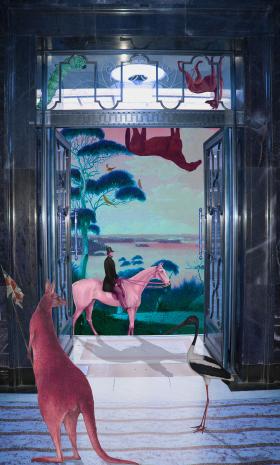A month in the library
COVID delayed my arrival in Sydney for my residency at the Library but I finally arrived — in a car full of equipment — after a journey from the South Coast. Used to dodging wombats, wallabies and echidnas, now I needed to navigate busy streets and rushing people.
During my residency I wanted to be led by curiosity as I looked at the Library’s location, the history of the site, its surrounding landscape and its relationship to local flora and fauna. I needed a time machine, but in many ways the Library is just that. It is on the land of the Eora people of the Gadigal Nation, country that was never ceded. I thought often about what the sounds and smells of this place would have been like before colonisation. Now it is a site that embraces a physical structure, archives, records, manuscripts, books, artworks, film and audio. It also reflects all those people who have contributed to what the Library is today and who work for its future.
On my first day, I was led along winding subterranean corridors, up and down elevators and along yet more corridors before arriving at the Fellows Room. Here I set up base camp. During my time in this auspicious room, I encountered fellows whose friendship and stories added to my experience. Launching into my research, I talked to the helpful librarians, read, searched the catalogue, and walked through the buildings, photographing, videoing, collecting audio and setting up timelapse and trap cameras both within the Library and up on the roof.
My work challenges our Eurocentric interpretation of the world. I have created my own term, ‘Eurotipodes’, which sets out to upend the notion that the Northern Hemisphere is the right way up and we hang upside down in our opposite ‘Antipodes’. To highlight this geographical and cultural bias, I often portray European imagery suspended upside down in the sky.
Animals appear frequently in my art, in painting, drawing and video. So one focus for me at the Library was on the creatures that would have been here before colonisation, as well as those that exist within the Library through the collection, the architecture and the decorative elements of the building. As well as those living on and around the building, including, of course, ibises. The animal hunt was on!
Over my month as Honorary Artist in Residence, with the assistance of Library staff for which I am very grateful, I collected a folio of source material with which to create contemporary digital artworks: moving image and video, animation, photomontage wallpaper, photomontage stills and projections. Doorways and windows in the building become portals into the past where I reimagine narratives that merge contemporary photographs and video with historical images from the collection.
The image shown here, a work in progress, makes the entry to the Mitchell Library Reading Room a hyper-coloured gateway to the past, featuring a tableau extracted from colonial paintings. A horse and hunting dog hang upside down in a strange landscape, while a kangaroo and stork peer uncomfortably from within the building.

Anna Glynn is an award-winning Australian artist who investigates connections between humans, history, nature and place. Her work is held in private collections and by major Australian cultural institutions. In 2023 she will be Artist in Residence at Mt Wilson, NSW, and in the Finnish Arctic Circle. She lives in Jaspers Brush on the NSW South Coast. You can see more of her work at annaglynn.com
This story appears in Openbook spring 2022.